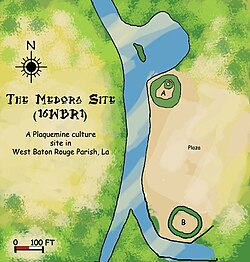 Diagram of the Medora site | |
| Location | Plaquemine, Louisiana, West Baton Rouge Parish, Louisiana, United States |
|---|---|
| Region | West Baton Rouge Parish, Louisiana |
| Coordinates | 30°19′36.34″N 91°12′5.65″W / 30.3267611°N 91.2015694°W |
| History | |
| Founded | 1300 CE |
| Cultures | Plaquemine culture |
| Site notes | |
| Excavation dates | 1939-1940 |
| Archaeologists | James A. Ford, George I. Quimby |
| Architecture | |
| Architectural styles | Platform mounds, Plaza |
| Responsible body: private | |
The Medora site (16WBR1) is an archaeological site that is a type site for the prehistoric Plaquemine culture period. The name for the culture is taken from the proximity of Medora to the town of Plaquemine, Louisiana.[1] The site is in West Baton Rouge Parish, Louisiana, and was inhabited from approximately 1300 to 1600 CE. It consisted of two mounds separated by a plaza. In the winter of 1939–1940 excavation of this site was undertaken by the Louisiana State Archaeological Survey, a joint project of Louisiana State University and the Work Projects Administration. It was directed by James A. Ford, and George I. Quimby. The excavations of the site were instrumental in defining the characteristics of the Plaquemine period and culture.[2]
- ^ "Louisiana Comprehensive Statewide Historic Preservation Plan". September 28, 2001. Retrieved 2009-05-30.[dead link]
- ^ Quimby, George Irving (1951). "The Medora Site of West Baton Rouge Parish, Louisiana". Anthropological Series, Field Museum of Natural History, Volume XXIV, Number 2. Chicago Field Museum Press.
